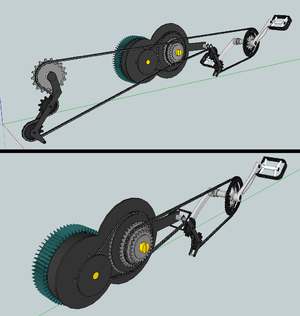
A bicycle, or bike, is a 2-wheeled vehicle for human transportation. They are generally human-powered by pedals (but see #Electric bicycles too). Bicycles are used for cycling.
While bicycles do take some resources to build and maintain (particularly various metals for frames and rubber for tyres), these are far lower than modern automobiles. Human-powered bicycles also do not require using non-renewable petroleum as a power source, do not emit any air pollution during use, and require far less parking space and heavy road infrastructure per person than is required for automobiles. They are also far less likely to kill and/or seriously injure cyclists or other street users such as pedestrians than heavy, motorised transport.
Consequently, there is much interest and renewed focus in the bicycle as an important part of the goal of Sustainable transport. This includes both in rural developing contexts, in urban centers in countries such as China and India where in many places the bicycle is still a majority form of mass transport, and in Western countries where explicit policies and infrastructure to encourage more cycling is seen as an important way to reduce the environmental impact of transport, and also to support improved public health due to their beneficial mild exercise aspect.
In comparison with automobiles, bicycles are a paradigm of energy efficient personal transportation. Bicycles increase mobility while alleviating congestion, lowering air and noise pollution, and increasing physical exercise. Most importantly, they do not emit climate-disturbing carbon dioxide.[1] Bike-sharing programs are booming throughout the world and are modeled in leading cities such as Paris, Amsterdam and London. Bike-sharing programs offer kiosks and docking stations that supply hundreds to thousands of bikes for rental throughout a city through small deposits or affordable memberships.
Another boom has occurred in electric bikes, especially in China and other Asian countries. Electric bikes are similar to plug-in hybridW vehicles in that they are battery powered and can be plugged into the provincial electric grid for recharging as needed. In contrast to plug-in hybrid cars, electric bikes do not directly use any fossil fuels. Adequate sustainable urban transportation is dependent upon proper city infrastructure and planning that incorporates efficient public transit along with bicycle and pedestrian-friendly pathways.[2]
Cycling[edit | edit source]

Cycling, bicycling or biking refers to using a bicycle as a means of personal transport or the transport of other people/cargo, for electricity generation, or as means of recreation, or sport.
Freight bicycle[edit | edit source]

Panniers and luggage carriers can be installed unto regular bicycles, ie to allow use of the bicycle as a freight bicycle.
Bicycles with lever arms[edit | edit source]

Bicycles can be equipped with lever arms, in order to reduce the effort required for the bicycling. The first bicycle with a lever arm was built by Maurice Houbracken. The effort required "reportedly" reduced the effort required by 50%. After a conversation with the builder though, it is clear that the system was built immediately without much prior designing. This would mean that much improvement is still possible (ie the lightgreen lever arm could possibly be attached elsewhere, on a more favorable position, and the angle might also be changed). Also, by increasing the lever arm, the fabricator stated that a 100% effort reduction is definitely possible, and perhaps that a redesign is thus useful for other purposes (ie vehicles where the driver takes another position; ie such as with the AT e-velomobile). Also, a similar lever arm could also be used for purposes other than transportation (ie winching,...).
Electric bicycles[edit | edit source]

Bicycles can also be fitted with an electric motor and a battery. If recharged with renewable energy, this is another sustainable option. Less effort means less sweat, but also less of the benefits of exercise. A great option when covering long distances or avoiding sweating (e.g. on the way to work in hot weather).
Bamboo bicycles[edit | edit source]
Several (traditional-styled) bikes have been produced mainly from bamboo. Price ranges of these vary greatly.[3][4][5][6]
Speculation follows: The likely difficulties include:
- Getting consistent size and shape of bamboo.
- Consistent mechanical problems (only if mechanical parts are made of bamboo or wood as well).
Avoiding splitting by use of special fittings and glue (mentioned in the article) - yet it must still be strong enough to safely carry a rider.
- Does the bamboo potentially create large splinters in the event of a serious accident? If so, these splinters could cause serious injuries
See also[edit | edit source]
References[edit | edit source]
- ↑ Brown, Lester R. Plan B 4.0: Mobilizing to Save Civilization. New York: W.W. Norton, 2009.
- ↑ Brown, Lester R. Plan B 4.0: Mobilizing to Save Civilization. New York: W.W. Norton, 2009.
- ↑ Bamboo Bike design 1
- ↑ Sustainable bamboo bikes
- ↑ [www.calfeedesign.com/products/bamboo/ Calfee bamboo bikes]
- ↑ Bamboo bike project